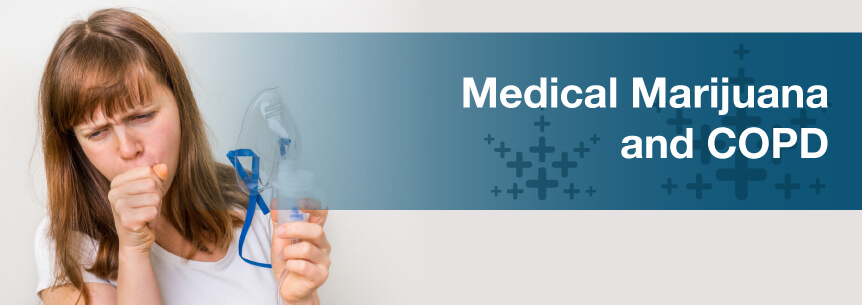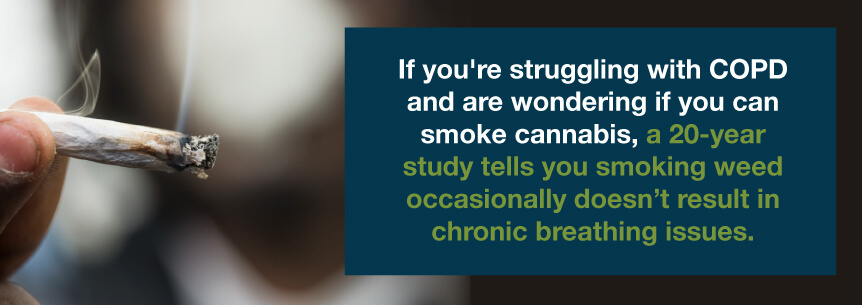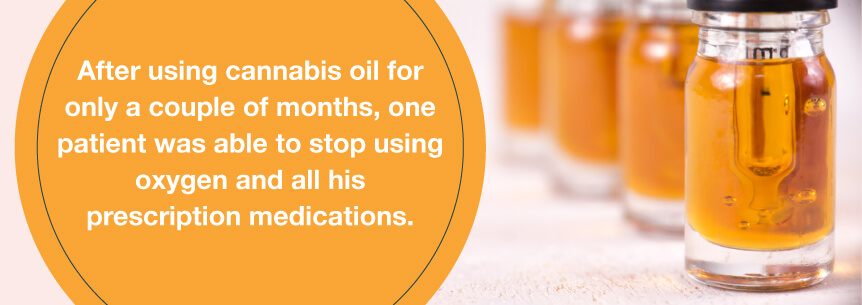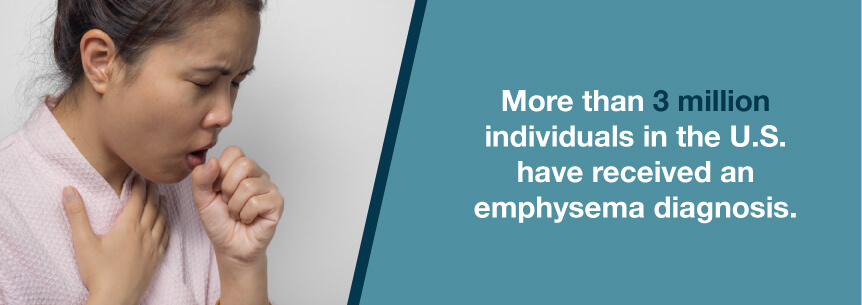
If you’re struggling with COPD and are wondering if you can smoke cannabis, a 20-year study tells you smoking weed occasionally doesn’t result in chronic breathing issues. But there’s more to it than that. In fact, medical marijuana for COPD may help those struggling with this progressive lung disease.

Even though marijuana smoke contains some of the same chemicals and toxins cigarettes do, researchers haven’t conclusively linked it to the lung damage cigarettes produce. Even so, since cannabis does contain many of the same toxins, it’s not unreasonable to assume the herb’s smoke may also damage the lungs. Because of this, scientists have been investigating if smoking cannabis may cause COPD.
For around 40 years, scientists studied the interaction between the lungs and marijuana and if pot increases the risk of pulmonary disease. They also studied marijuana’s potential as a COPD treatment.
Several smaller studies suggested a link between cannabis and lung cancer, but the connection between them wasn’t conclusive — either because sample sizes were too small, or the scientists didn’t limit tobacco smoking as a control factor.
In fact, in the early 1970s, one researcher found smoking the herb helped dilate airways instead of constricting them, leading to a substantial amount of bronchodilation.
Other studies show marijuana for COPD may provide therapeutic benefits to help patients manage acute airway constriction attacks caused by inflammation and provide a preventive measure. Studies have long shown medical pot effectively reduces inflammation, suggesting it may help manage inflamed airways in patients who also have chronic bronchitis.
Since CBD offers a powerful anti-inflammatory effect as well as improves the function of lungs, it may prove to be a therapeutic means of treating inflammatory lung diseases.
Find A Doctor Find A Dispensary
Recent medical developments show weed effectively treats respiratory illness through its anti-inflammatory properties. The cannabinoids in marijuana provide this therapeutic benefit. They also help with other functions, such as:
The best cannabis and COPD strains include Indica-dominant hybrids.
Some recommended strains include:
All these strains may help relieve insomnia and inflammation. They are expectorants and have antimicrobial and analgesic characteristics. They may also help support your immune system, which is important for COPD patients. Because of these qualities, they make the best marijuana and COPD strains to use in your treatment.
Because you know smoking cigarettes is harmful and can lead to lung cancer or COPD, it may cause you to worry about smoking medical cannabis for COPD. Until you feel comfortable with smoking the herb or have talked to your physician about it, there are other alternative consumption methods available to you.
These days, cannabis may be:
Ingesting cannabis through highly condensed, potent oil extract has shown better results. In fact, many cannabis advocates are already making oil themselves, particularly in medical weed-friendly states.
After using cannabis oil for only a couple of months, one patient was able to stop using oxygen and all his prescription medications. Today, he walks anywhere from two to five miles a day and says using cannabis oil helped him get his life back.

If you’re on the fence about using cannabis for your COPD, you should sit down with a qualified doctor who can help educate you about the risks and benefits. Then, you’ll have the knowledge you need to make an informed decision on whether you should include the herb in your COPD treatment plan. Search for a cannabis dispensary or connect with medical marijuana doctor today to get your questions answered and begin the marijuana and COPD process.
Find A Doctor Find A Dispensary
COPD, or chronic obstructive pulmonary disease, is a persistent inflammatory lung disease resulting in obstructions in your lung’s airflow. Smoking cigarettes is the leading cause of COPD, and most patients are either current or former smokers. However, up to 25 percent of COPD patients never smoked.
Other factors contribute to COPD, including long-term exposure to lung irritants, like chemical fumes, dust and air pollution. You may also develop the disease through an alpha-1 anti-trypsin deficiency — a rare genetic condition.
Treatments for COPD can aid you in managing the disease in the best way possible, and those with chronic obstructive pulmonary disease can control their symptoms and achieve a good quality of life, particularly in the earlier stages of the condition. They may also reduce their risk of other ailments associated with COPD.
When you have COPD, you experience shortness of breath and have trouble breathing. COPD is an umbrella term, as there are two primary subtypes of chronic obstructive pulmonary disease: emphysema and chronic bronchitis. Many COPD patients have both of these subtypes.
Emphysema damages your lung’s air sacs and causes them to expand and burst. When there’s damage to this area, you find it difficult to expel air from your lungs, leading to a carbon dioxide buildup in your body and a whole array of other emphysema symptoms, including:
More than 3 million individuals in the U.S. have received an emphysema diagnosis.

Chronic bronchitis causes airway irritation and inflammation. Your airways are the tubes in your lungs where the air flows through. When these tubes become irritated and inflamed, thick mucus begins to form.
As time passes, this mucus plugs up your airways and makes it difficult to breathe. You then cough up mucus excretions, known as phlegm or sputum.
The symptoms of chronic bronchitis include:
In the past year, around 9.3 million adults received a diagnosis of chronic bronchitis.
COPD goes back as far as the mid-1600s, according to history provided by the Lung Institute. Knowledge of COPD started in the mid-17th century through the writings of Theophile Bonet, a Swiss-born physician. After performing more than 3,000 patient autopsies, he first described emphysema’s effects on the lungs.
Charles Badham, a British physician, was the first person to use the term “bronchitis” in 1814 to refer to inflammatory changes in the mucous membrane. Physicians learned a lot about the lungs by the 1950s. During the Ciba Guest Symposium meeting in 1959, the assembled medical professionals made up a complete list of components for defining and diagnosing COPD.
You don’t usually experience COPD symptoms until you have significant damage to your lungs. Symptoms tend to get worse, especially if you still have exposure to smoking. Symptoms of COPD may include:
Individuals who have COPD may experience exacerbation episodes, where their symptoms get worse than usual and continue for a few days.
If you’re living with COPD, each breath you take may seem difficult. COPD patients are at risk of serious complications or life-threatening effects. Some effects include:
Because smoking is the No. 1 cause of COPD, it doesn’t come as a surprise to find many COPD patients often develop lung cancer.
When viruses or bacteria enter your lungs, they create infection and pneumonia occurs. If you have a vulnerable pulmonary system, pneumonia can be especially dangerous, since it can damage your lungs further. When this happens, it creates a cycle of illnesses, further weakening your lungs and rapidly deteriorating your health.
Heart failure is a considerable complication of COPD. Since COPD leads to lower oxygen levels in your bloodstream, your heart could suffer. And, because many heart failure symptoms are similar to COPD symptoms, it can be hard to recognize you’re having problems with your heart until it’s too late.
Patients with severe COPD often experience gradual mental decline, making it difficult to manage your symptoms, particularly if you’re older. Complications such as high carbon dioxide, low oxygen and brain blood vessel damage caused by smoking can contribute to dementia with COPD.
While COPD doesn’t cause you to develop diabetes, if you already have diabetes, COPD can make it more difficult for you to fight your symptoms. A significant complication when you have both diabetes and COPD is that many medications for these diseases interact harmfully. Diabetes may also restrict your cardiovascular system. Therefore, you’ll find your COPD and diabetes symptoms worsen.
As with any chronic disease, having COPD can leave you feeling hopeless and depressed. Sleepiness, fatigue and other COPD symptoms are related to depression, and eating problems, the need for supplemental oxygen and other effects of the disorder can also make you experience the blues.
Also, you’re more susceptible to anxiety when you have COPD. Having a hard time breathing and not being able to catch your breath can be incredibly anxiety-provoking. Therefore, as a COPD patient, you may always worry about having a bout with shortness of breath.
If your breathing becomes an issue due to the air quality you breathe or a similar problem, your brain may set off an internal “suffocation alarm” that causes a wave of fearsome distress and panic.
Panic causes:
This kind of mindset may trigger overwhelming feelings, and you’ll experience more anxiety from these overactive false alarms.
According to the World Health Organization, facts surrounding COPD include:
Quitting smoking is the most optimal way to slow down the progression of your COPD. In fact, it’s the most vital first step, even if you think it’s too late to quit. It doesn’t matter how severe your condition is or how long you’ve been smoking — you can stop further lung damage by quitting smoking.
Your doctor manages your symptoms through various treatments to help you feel better.
You inhale most COPD medications, and they go directly to your lungs to help you breathe easier. Your doctor will show you how to use your inhaler correctly.
Some medications your doctor may prescribe include:
— These are typically inhaler medications designed to relax your airway muscles. They help relieve shortness of breath and coughing, making it easier to breathe.
You may experience:
— Daliresp is a newer type of medicine for individuals with severe COPD who also have chronic bronchitis. It relaxes your airways, since it decreases inflammation. Side effects may include weight loss and diarrhea.
— These are inhaled corticosteroid medicines to help prevent exacerbations and reduce inflammation in your airways. Side effects may include oral infections, bruising or hoarseness.
— When you have a severe acute exacerbation, your doctor may prescribe short courses of oral corticosteroids to help prevent your COPD from getting worse. You shouldn’t use oral steroids long-term, since they can have harmful side effects like osteoporosis, diabetes, increased risk of infection, cataracts and weight gain.
— An inexpensive medicine, theophylline may help prevent exacerbations and improve your breathing. Side effects may include a headache, nausea, tremor and fast heartbeat.
In pulmonary rehab, you learn how to manage your COPD. You’ll have a team of health experts who will offer you counseling and educate you on how to exercise, breathe easier and eat a balanced diet.
When you’re not getting enough oxygen to your blood, your doctor may prescribe oxygen therapy. A variety of devices can supply your lungs with oxygen, including portable, lightweight units you’ll be able to carry along with you while you’re out running errands or enjoying activities.
Since you’re more prone to lung infections with COPD, your doctor may recommend a flu vaccine annually. They may also recommend a pneumococcal shot. Even though this shot won’t prevent the occurrence of pneumonia, you may not get as sick if you do get it.
Although COPD doesn’t have a cure, there are recent stem cell therapy advancements making it possible to not just relieve your symptoms, but also help your lungs heal themselves. In fact, during a testing of stem cell therapy in 349 patients, within three months of being treated, 84.5 percent of them experienced an improved quality of life, according to the Lung Institute.

Pulmonary rehabilitation includes education, exercise and support to teach you the highest level of breathing and functioning possible. During this rehabilitation program, you’ll have a team of professionals who will work with you closely to help you manage your COPD, improve your physical health and keep you active and healthy long after you’ve finished the program.


Please allow us to access your location to find local dispensaries.
VIEW ALL DISPENSARIES ➔